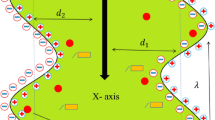Abstract
Homogeneous consecutive chemical reactions in turbulent flow system is analyzed in this paper. Arbitrary chemical reaction order is considered. The governing nonlinear material balance equations are solved numerically on a digital computer. It is seen from the preliminary numerical results that high Reynolds and Schmidt numbers significantly increase both reaction velocities.
Similar content being viewed by others
Abbreviations
- c i :
-
concentration of i species, g. mole/cm3
- C i :
-
dimensionless concentration of i species, c i /c A0
- c A0 :
-
inlet concentration of A, g. mole/cm3
- D i :
-
molecular diffusivity of i species, cm2/sec.
- f :
-
Fanning friction factor
- k 1 :
-
first reaction rate coefficient, (g. mole/cm3)1−m/sec.
- k 2 :
-
second reaction rate coefficient, (g. mole/cm3)1−n/sec.
- K 1 :
-
dimensionless first reaction rate coefficient, k 1 r 20 c −1 A0 /D A
- K 2 :
-
dimensionless second reaction rate coefficient, k 2 r 20 c −1 A0 /D A
- m :
-
order of the first chemical reaction
- n :
-
order of the second chemical reaction
- r :
-
radial distance, cm
- r 0 :
-
reactor radius, cm
- R :
-
dimensionless radial distance, r/r 0
- Re:
-
Reynolds number, r 0 ū/ν
- Sc:
-
Schmidt number, D/ν
- u :
-
local velocity, cm
- ū :
-
bulk velocity, cm
- U :
-
dimensionless local velocity, u/ū
- X, Y :
-
dimensionless concentrations of A and B, c i /c A 0
- xxx0058;, xxx0059; :
-
dimensionless bulk concentrations of A and B
- z :
-
axial distance, cm
- Z :
-
dimensionless axial distance, zD A /r 20 ū
- α :
-
ratio of eddy mass diffusivity to eddy viscosity, ε/ν
- ε :
-
eddy mass diffusivity, cm2/sec.
- ν :
-
kinematic viscosity, cm2/sec.
References
Lyczkowski, R. W., D. Gidaspow and C. W. Solbrig, Chem. Eng. Prog. Sym posium Series 63 (1967) 1.
Villermaux, J., Int. J. Heat and Mass Transfer 14, (1971) 1963.
Wissler, E. H. and R. S. Schechter, Chem. Eng. Sci. 17 (1962) 937.
Lyczkowski, R. W., D. Gidaspow and C. W. Solbrig, AIChE J. 17 (1971) 497.
Randhava, S. S. and D. T. Wasan, AIChE J. 17 (1971) 664
Acrivos, A. and P. L. Chambre, Ind. Eng. Chem. 49 (1957) 1025.
Hudson, J. L., AIChE J. 11 (1965) 943.
Wissler, E. H. and R. S. Schechter, Appl. Sci. Res. A10 (1961) 198.
Hobler, T. Chemia Stosowana (Poland) 1 (1957) 21; abstracted in British Chem. Eng. 3 (1958) 329.
Strunk, M. R. and F. F. Tao, AIChE J. 10 (1964) 269.
Lapidus, L., Digital Computation for Chemical Engineers, McGraw-Hill, New York, 1962.
Author information
Authors and Affiliations
Rights and permissions
About this article
Cite this article
Lin, S.H. Consecutive chemical reactions in a turbular reactor with turbulent flow. Appl. Sci. Res. 27, 375–386 (1973). https://doi.org/10.1007/BF00382500
Received:
Revised:
Issue Date:
DOI: https://doi.org/10.1007/BF00382500




